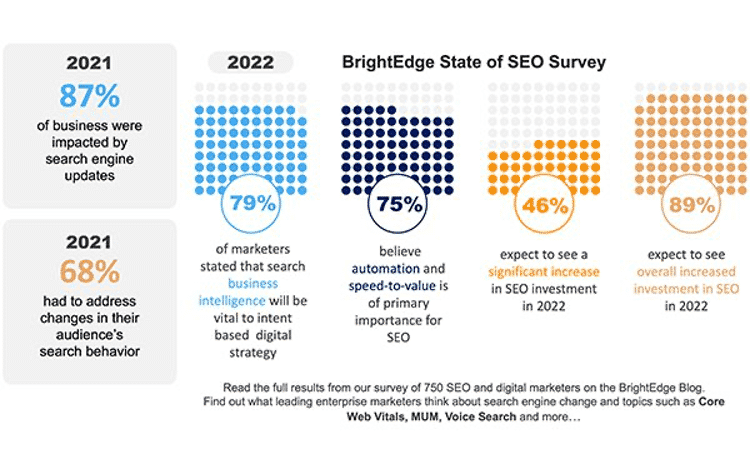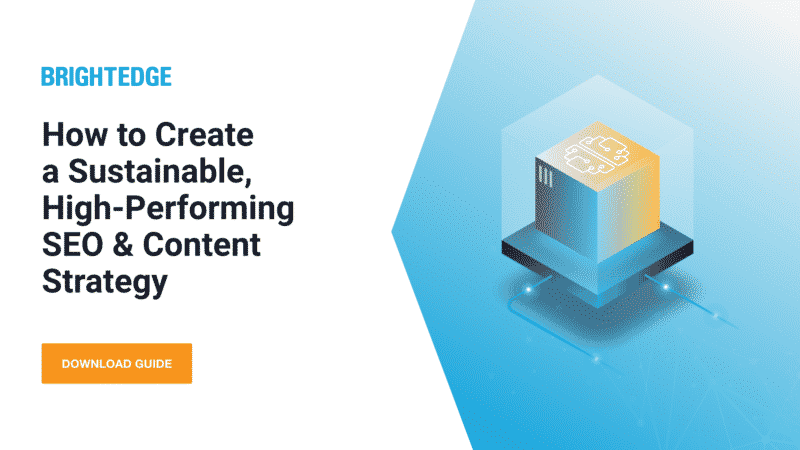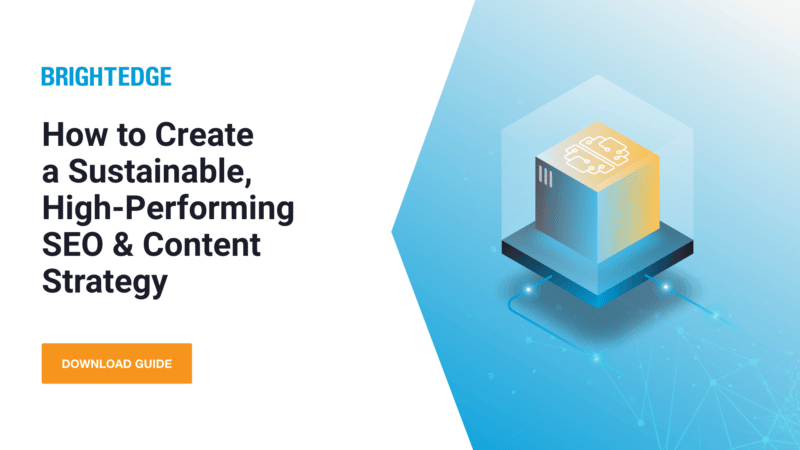Consumers are an inquisitive lot. They seek out the best prices, look for new recipes, explore options for travel destinations, find doctors and new restaurants and bike trails and they use search engines more than any other channel to do it. Marketers of all stripes know this, which may be why, on average, marketers are investing more resources into content and SEO in 2022.
What marketers don’t always know, especially those of us tasked with SEO and content creation, is what content will be both sought out by consumers and valued highly enough by the search engine’s algorithm to earn a top ranking. Both requirements must be met for content to succeed in reaching the right people, and it’s not an easy task.
To have the best chance, marketers need to:
- Know what consumers are searching for
- Be able to identify patterns in those searches, including prominent keywords
- Understand external factors, including competitiveness for the most valuable searches and mitigating influences like geography, seasonality, and the impact of world events
And that is just scratching the surface. Fortunately, organic search leaves a data-rich trail that can be leveraged to support a sustainable, high-performing SEO and content strategy. Winning high ranks is never guaranteed, but with the right insights, marketers can tip the scales in their favor.

A sustainable, high-performing SEO and content strategy starts with research
Content by itself does not drive traffic – after all, less than 10% of all content generates any traffic at all – and SEO by itself does not drive conversion. In practice, getting meaningful traffic from organic search requires a coordinated SEO and content strategy, the foundation of which is research.
To make the most of the available data surrounding content, search activity and website traffic, an SEO and content strategy should account for research insights at four key junctures in a recurring loop:
- To establish a baseline for website performance
- To identify topic opportunities, gauge demand and benchmark competitors
- To create and optimize content
- To track, measure and refine content and SEO
Establish a baseline for website performance
To develop a targeted SEO and content strategy, it’s important to first understand how your site performs in organic search. This effort should incorporate both a content audit and a technical audit. The audits will help to identify and prioritize opportunities and provide a baseline against which to measure the impact of the strategy over time.
From an organic search perspective, a content audit should identify a comprehensive list of the keywords – and by extension, the pages – that help the website or domain rank in a search engine. Existing high-ranked content offers a prospective model for new content. Assess the topics, substance and structure of the content to identify patterns that can be leveraged in the larger strategy. Lower ranked keywords and pages may represent a further opportunity for quick gains if that content can be optimized to earn a higher rank.
Search algorithms are automated. In addition to keywords, they rely on technical signals found in the site and page architecture to help them contextualize the content on the page and determine its value for search audiences. A technical audit for SEO will uncover technical issues and opportunities and help ensure that the site and page can be made compliant with best practices. This can include on-page elements such as H1 and H2 tags, site elements like page speed and mobile-friendliness, and opportunities to better contextualize content, for example, by adding links to authoritative content.
Identify topic opportunities, gauge demand and benchmark competitors
The bulk of opportunity typically lies beyond existing content. Relevant, prospective audiences are presented with search results for countless searches every day. In fact, SEO is responsible for over 53% of website traffic. Those searches hold a treasure trove of intelligence about the keywords, pages, domains, and competitors that are highly ranked and win the most clicks.
A targeted SEO and content strategy must identify and analyze the winners in the market to displace them.
Begin with understanding which topics people are searching for and what keywords and phrases they use to search. Identify within that data the topics you are best positioned to address. The goal here is to get relevant traffic that is most likely to convert. A site that sells zebra-print hair ties and accessories will want to rank highly for searches like “animal print headband.”
Analyze the content that is ranking highly for your coveted searches. It’s important to understand that in the world of search, these are your competitors, and they may not be the same as your traditional competitors. The San Diego Zoo may not be a business competitor, but if they are ranking high for “animal print headband,” they are your search competitor. Determine what competitor pages and keywords are ranking well for and factor that into your content strategy.
Create and optimize content
All the research you conduct will be used to create and optimize content. Determine what is important to your business, then plan against your baseline research and factor in the insights gained from topic, keyword and competitive analysis to develop a content strategy for search.
Importantly, the potential for content to rank depends not only on the substance of the content but the format. The search engine results page (SERP) is a multi-faceted collection of result types, from traditional web listings to locations to videos and images, quick answers, shopping carousels and more. With the right tools, you can determine not only what topics and keywords will help you rank but what type of content is best suited for a high ranking.
Track, measure and refine content strategy and SEO
For simplicity’s sake, we’re discussing the cycle of research, content creation and optimization as a linear process, but in practice, it is a loop. Research is not a one-and-done sort of undertaking but must be ongoing. Search ranks are dynamic and search engine algorithms are always changing to improve the quality of results and adapt to innovative technology.
The performance baseline created at the start of the SEO and content effort provides a framework for tracking and measuring ongoing performance. How much has the site’s share of voice grown or declined? What pages have begun to rank or improved in rank? What drove those improvements, and can they be leveraged for additional performance gains? Which new keywords have emerged, and which have declined in search interest?
Actively measuring performance provides the insights needed for ongoing, targeted content creation and optimization.
Research-based SEO and content strategy in practice
It is helpful to look at a real-world example of a research-based SEO and content strategy. The Nestle Meritene example below provides a snapshot of how search data can be leveraged to enrich a company’s understanding of the market and improve its share of voice in the all-important search channel. Nestle, a client of BrightEdge, used Data Cube, our enterprise solution for companies looking to implement research-based SEO and content strategies. You can read the full Nestle case study and an additional case study on Dumpsters.com in the Data Cube product guide.
BrightEdge Data Cube supports all four phases of research-based SEO and content strategy. To learn more about how Data Cube can support your SEO and content strategy, contact us to schedule a demo.
Nestle Health Science – MERITENE®
The MERITENE team, working with its agency to obtain the desired relevance in search engines, employed a strategy to prioritize keywords with the highest search volume. They first conducted research to discover high-value keywords with a minimum of 29,000 monthly searches.
They followed targeted recommendations, optimizing meta tags and existing content to improve SEO performance. Where content didn’t currently exist, they developed SEO-friendly content based on “habits of healthy living” and food supplements using the language their consumers use in search.
Over the course of the first year, they earned page one rankings for more than 90 previously unranked terms related to health. The gains increased traffic from a nascent 435 users in Q1 to 67,735 in Q4.
The post How-to guide: Create a sustainable, high-performing SEO and content strategy appeared first on Search Engine Land.
Source: Search Engine Land


